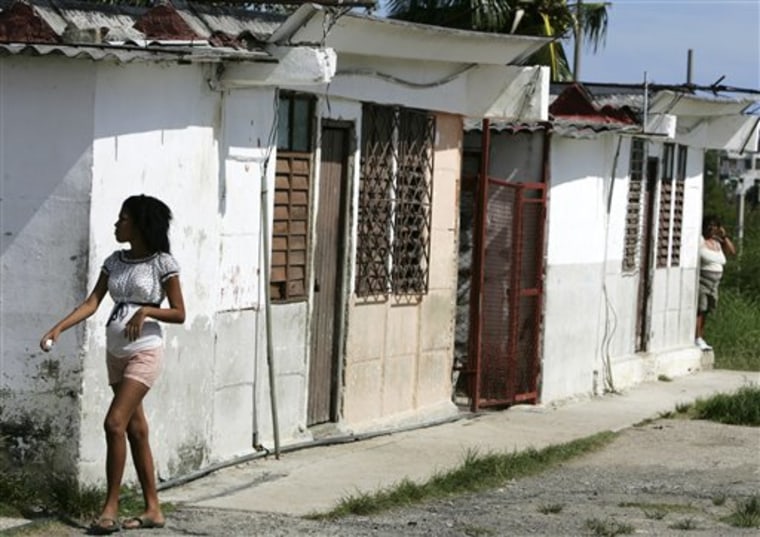When Hurricane Charlie tore through her apartment, Marcia Escalona considered herself lucky to land temporary housing on the Cuban capital's remote outskirts while communist authorities pledged to help her rebuild.
But four years later, it no longer feels temporary.
"They told me it would be six months, but that was in 2004, and I want out of here already," said the 48-year-old kindergarten supervisor who lives with her husband and 22-year-old son in two rooms with concrete walls and a leaky roof in Bahia, a community of temporary homes in Havana del Este, or East Havana.
Now hundreds of thousands of Cubans blown from their homes by Hurricanes Gustav and Ike have joined Escalona in line for scarce housing. And damage to infrastructure, crops and farm equipment means the government may have to use its resources for food before building materials.
Gustav and Ike roared through the island eight days apart in late August and early September, killing seven Cubans and damaging nearly half a million homes, even while some Cubans forced into temporary, "in-transit" shelter by previous storms have waited years — even decades — for new places to live.
Hurricane victims in other poor countries, such as Haiti, cannot dream of even temporary government-provided shelter. And in the United States, three years after Hurricane Katrina, thousands of low-income families continue to live in temporary housing because the storm wiped out affordable rental units.
Cuban Housing Institute officials are absorbed in rebuilding and won't be available for some time to talk about the "in-transit" program, a government spokeswoman said. No official figures were available on how many Cubans were already living in temporary housing before Gustav and Ike struck.
But the storms exacerbated a severe housing crisis in the country of 11 million, where apartments are so hard to find that couples often continue to share homes even after divorces.
Backlog at least 500,000
In 2005, Cuban officials said they needed more than 500,000 additional homes and the problem has only gotten worse since then.

About 450,000 homes were damaged, more than 63,000 of them beyond repair. At least 200,000 Cubans were left newly homeless and the government says "hundreds of thousands more" may have to find temporary housing.
Cuba's communist government controls nearly all housing and citizens depend on the state for all new construction or major repairs, leaving those who lost their homes with little choice but to rely on government officials.
In Bahia, life "in-transit" features barracks-style buildings, each with 15 apartments where residents hang sheets to separate kitchens from living rooms and sleeping quarters. There's a medical clinic and almost everyone has a television set and refrigerator, as well as some furniture salvaged from their former homes.
There are sinks and toilets with no seats, but the pipes often run dry. The dwellings were designed to be lived in for just a few weeks, and ventilation is poor, so rooms are filled all day, everyday with moist, oppressive heat.
"My nerves are shot, my blood pressure is up," Escalona said. "You can't breathe. The heat suffocates you."
Heading outside is little relief. An overflowing septic system sends sewage running through the stumpy grass between each row of apartments, creating an overwhelming stench and swarms of mosquitoes.
Like Escalona, Sara Pena lived in Havana's leafy Vedado district until Charlie shredded her roof. She waits hours for spotty bus service to her old neighborhood, where she works and her son attends school.
"But at least I have a roof over my head," she said.
Cubans in temporary housing are placed on waiting lists for new homes in their old neighborhoods.
'Like we are animals'
Up a nearby hill, a shabbier collection of 210 temporary homes overflows with families whose dilapidated apartment buildings collapsed in Havana's historic district.
"There are people here who live 10 to a room. It's like we are animals," said a burly 32-year-old in knockoff designer sunglasses who said he had lived in temporary housing for 17 years, but declined to give his name.
Officially, those left homeless by severe weather get priority for new places — a fact not lost on those displaced by the routine decay of buildings in Old Havana.
"I think they have more hope than we do," Damarias Gualidan said of the storm victims. "Because nothing fell down on us during a hurricane, they aren't going to give us anything," added Gualidan, who has spent the past decade in temporary housing.
Xudaisy Orozco, a 28-year-old hospital employee, was even more pessimistic.
"It's like the end of the world here," she said. "But there's nowhere else for us."
